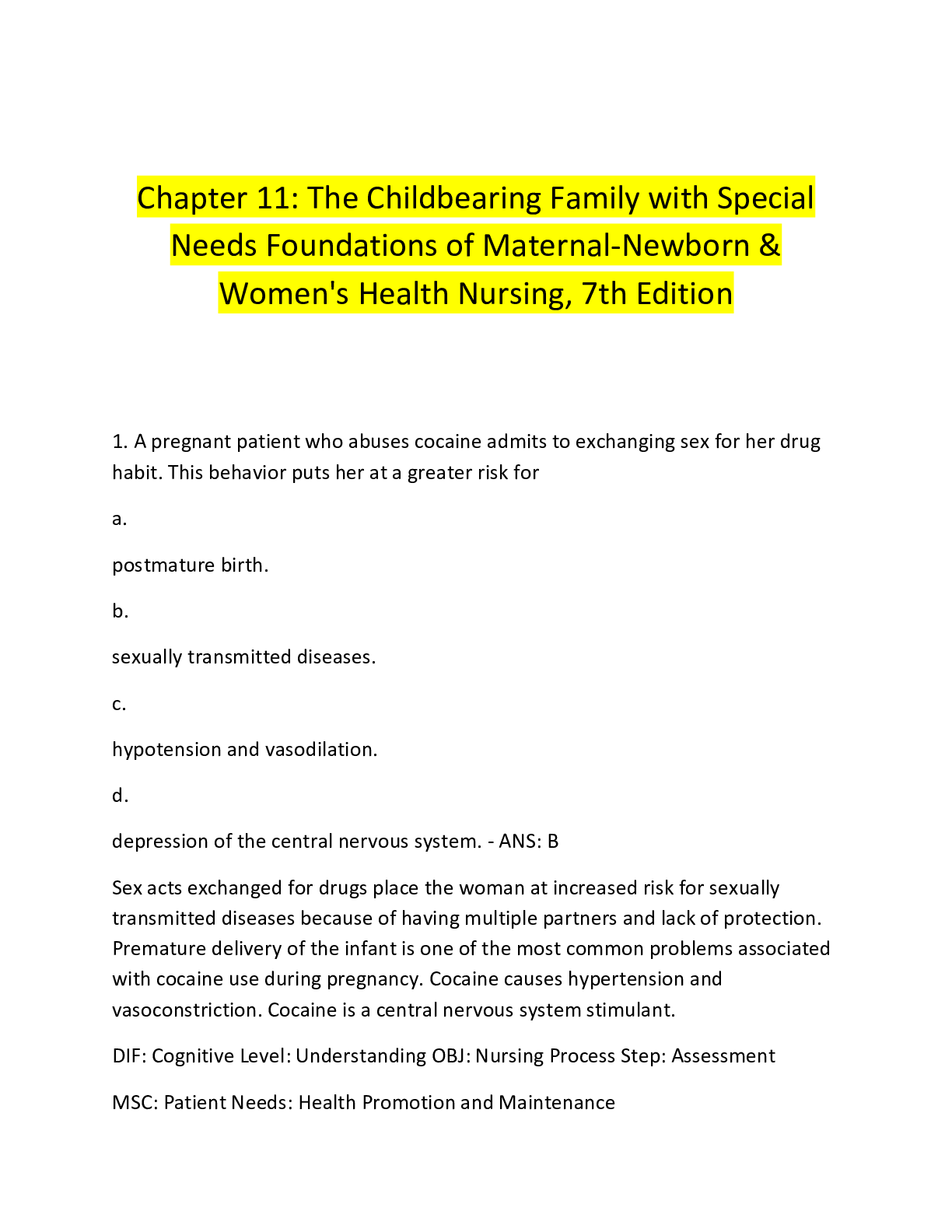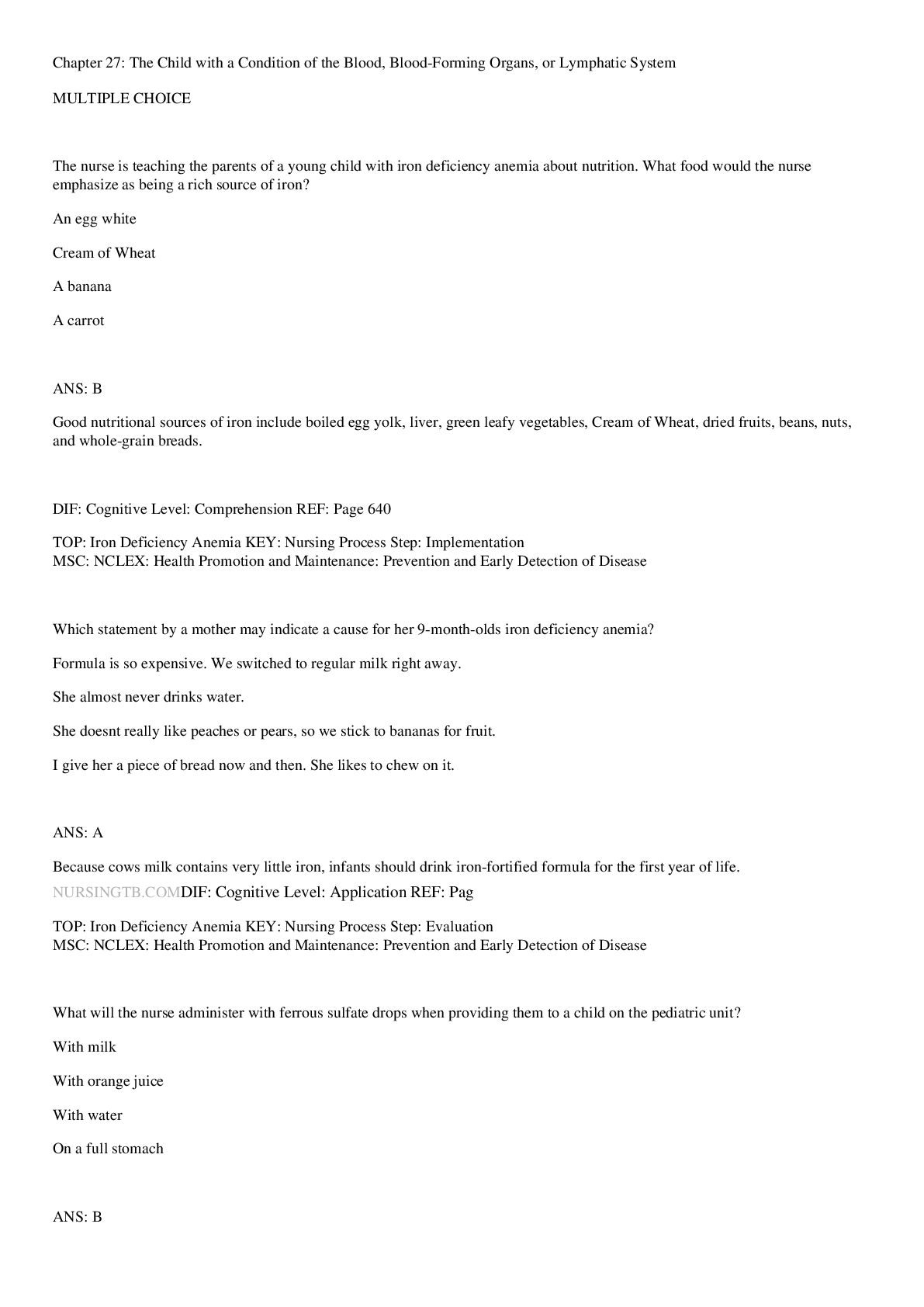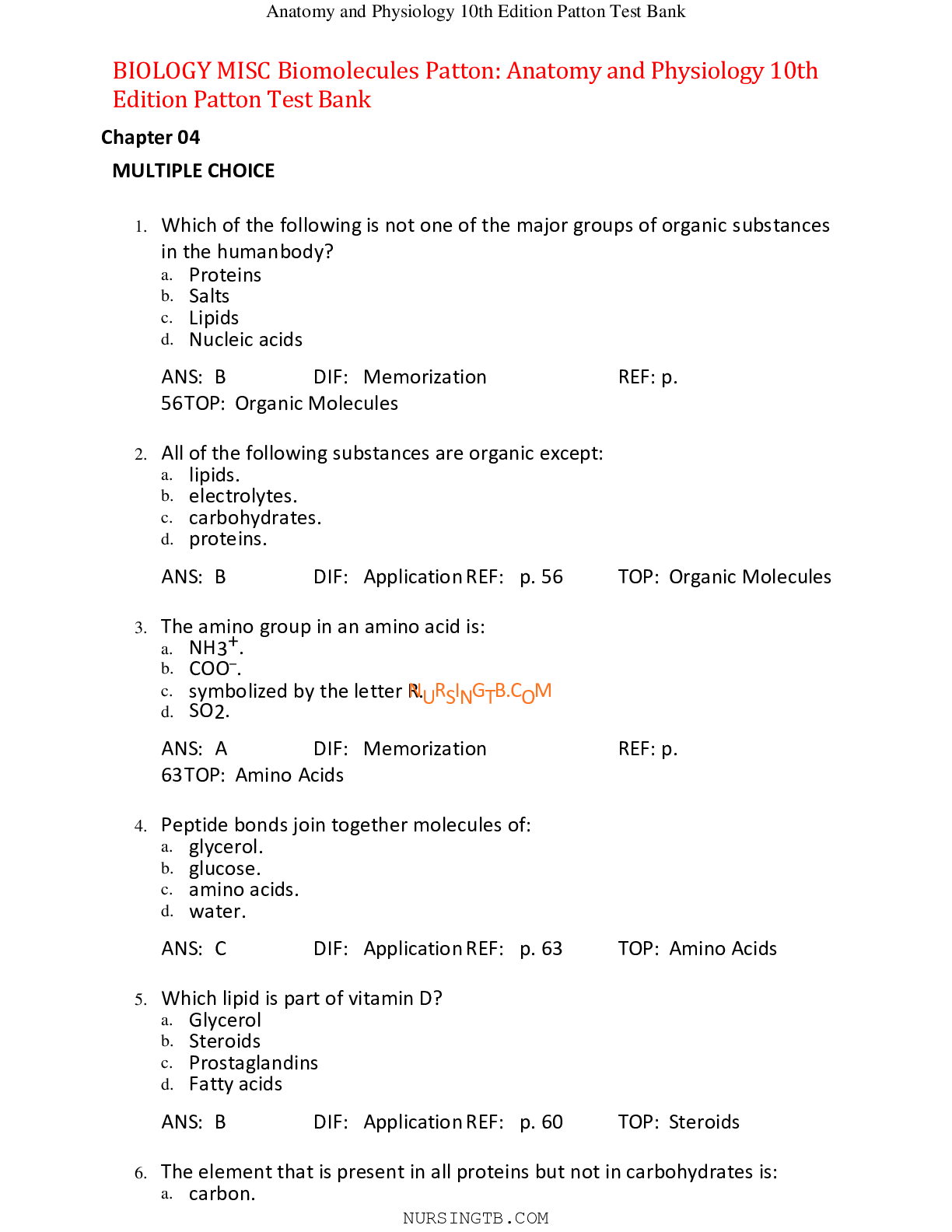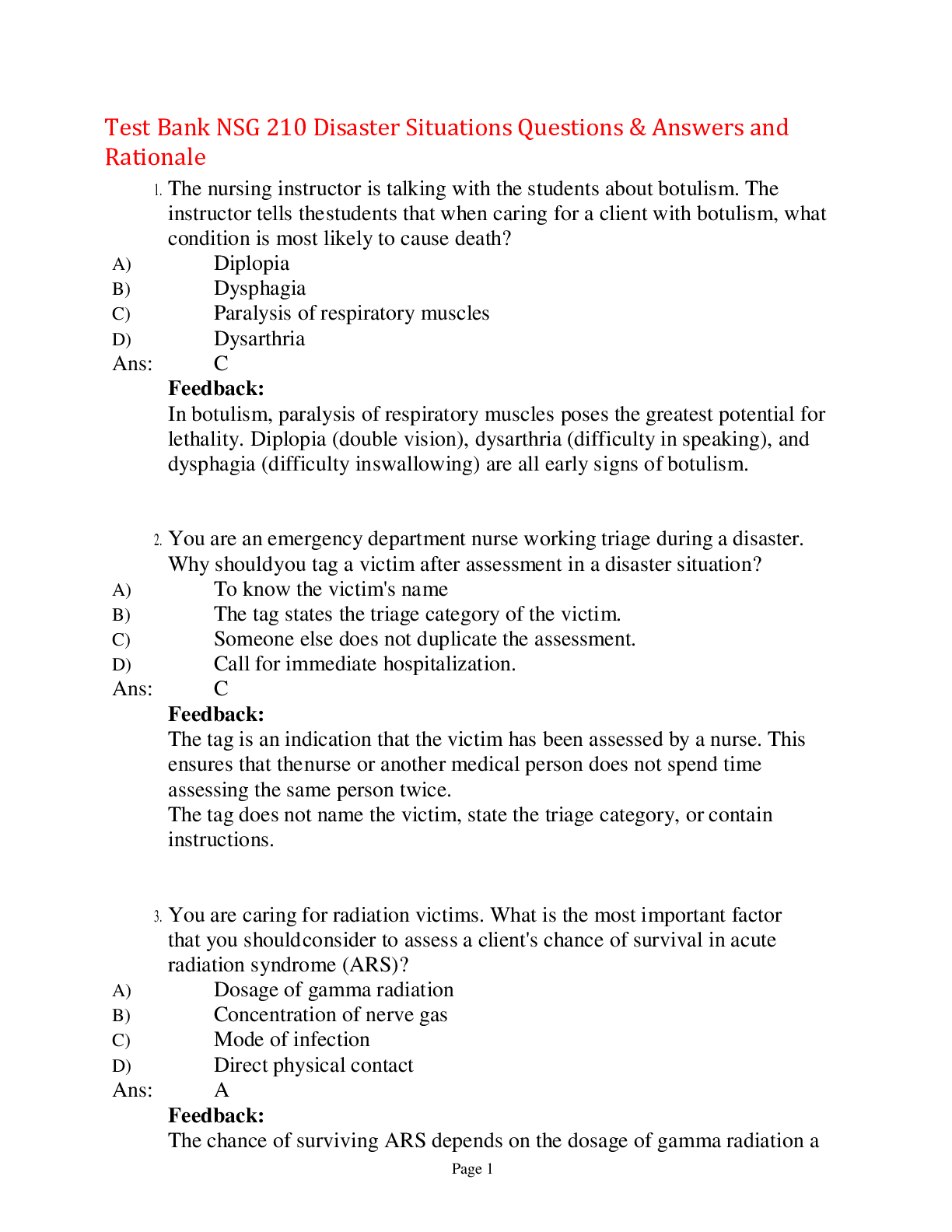*NURSING > TEST BANK > Test Bank NURS 2900 Pain Management [1] Questions & Answers and Rationale,100% CORRECT (All)
Test Bank NURS 2900 Pain Management [1] Questions & Answers and Rationale,100% CORRECT
Document Content and Description Below
Test Bank NURS 2900 Pain Management [1] Questions & Answers and Rationale 1.A client is being taught to self-administer a narcotic analgesic by means of an intravenous pump system. Which of the follo... wing functions is designed to help prevent the patient from unintentionally overdosing? A) Reducing the dosage of the narcotic analgesic B) Reducing the frequency of administration of the narcotic analgesic C) Programming the dosage and time interval into the device D) Drawing up a schedule chart for the client Ans: C Feedback: When the client is being taught to self-administer a narcotic analgesic, the dosage and time interval between doses are programmed into the intravenous pump system to prevent accidental overdose. The frequency or dosage of the narcotic analgesic need not be reduced. Although a schedule chart is useful to the client, it does not effectively prevent accidental overdose. 2. Which of the following nursing interventions contributes to achieving a client's pain relief? A) Minimize the client's description of pain or need for pain relief. B) Collaborate with the client about his or her goal for a level of pain relief. C) Use all forms of available pain management techniques. D) Prevent the client from self-administering analgesics. Ans: B Feedback: The nurse should collaborate with each client about his or her goal for a level of pain relief; this helps implement interventions for achieving the goal. The client's description of pain or need for pain relief should never doubted or minimized. The client need not refrain from self-administering analgesics; providing a client with equipment to self- administer analgesics promotes a more consistent level of pain relief. The nurse should also inform the client of available pain management techniques and incorporate any preferences or objections to interventions for pain management that the client may have when establishing a plan of care; using all forms of available pain management techniques is not necessary. 3. How should the administration of analgesics be scheduled to provide a uniform level of pain relief to a client? A) Administering the analgesics on a regular basis, as per physician's order B) Administering the analgesics intravenously C) Administering the analgesics on an as-needed basis D) Administering analgesics with increased dosage Ans: A Feedback: Scheduling the administration of analgesics every 3 hours, rather than on an as-needed basis, often affords a uniform level of pain relief. Administering the analgesics intravenously or with increased dosage is not advisable unless prescribed by the physician. 4.A client is prescribed pain medications. Which of the following interventions will enable the client to consume an adequate meal during treatment? A) Administer the medication with plenty of fruit juice. B) Administer the medication intravenously. C) Administer the medication 30 to 45 minutes before meals. D) Administer the medication 30 to 45 minutes after meals. Ans: C Feedback: Some pain medications may cause nausea or sedation. However, pain medications administered 30 to 45 minutes before meals may enable the client to consume enough food. Administering the medication with plenty of fruit juice, intravenously, or 30 to 45 minutes after meals does not minimize the risk for imbalanced nutrition in a client with pain. 5.A client has been using NSAIDs daily over an extended period. Which of the following effects should the nurse carefully monitor for in this client? A) Cardiac disorders B) Urinary tract infection C) Hypothyroidism D) Gastrointestinal bleeding Ans: D Feedback: NSAIDs when used daily over an extended period may cause undesirable side effects such as gastrointestinal bleeding and hemorrhagic disorders. Use of analgesics does not increase the risk for developing cardiac disorders, urinary tract infections, or hypothyroidism. 6. An older adult is being treated with opioids for pain relief. Which of the following should the nurse strongly recommend to this client? A) Exercise regularly. B) Avoid harsh sunlight. C) Follow a bowel regimen. D) Reduce fiber intake. Ans: C Feedback: The nurse should ensure that a bowel regimen to prevent constipation is started when any older adult is treated with opioids. A high-fiber diet along with increased fluids should be encouraged. The client should not reduce fiber intake because this increases the risk for constipation. The client need not exercise regularly or avoid harsh sunlight because these have no effects on the drug therapy. 7. Which phase of pain transmission occurs when the one is made aware of pain? A) Transmission B) Modulation C) Transduction D) Perception Ans: D Feedback: Perception is the phase of impulse transmission during which the brain experiences pain at a conscious level, but many concomitant neural activities occur almost simultaneously. Transmission is the phase during which peripheral nerve fibers from synapses with neurons in the spinal cord. Modulation is the last phase of pain impulse transmission during which the brain interacts with the spinal nerves in a downward fashion to alter the pain experience. Transduction is the conversion of chemical information in the cellular environment to electrical impulses that move toward the spinal cord. 8. Which of the following is the most important potential nursing diagnosis for the client receiving opiate therapy? A) Risk for Injury B) Risk for Impaired Gas Exchange C) Diarrhea D) Altered Mobility Ans: B Feedback: Problems that may develop with opioid and opiate therapy include Risk for Impaired Gas Exchange related to respiratory depression, Constipation related to slowed peristalsis, and Risk for Injury related to drowsiness and unsteady gait. 9. Which of the following is the only reliable source for quantifying pain? A) The nurse B) The pain assessment tool C) The physician D) The client Ans: D Feedback: The client is the only responsible source for quantifying pain. The nurse, the pain assessment tool, and the physician are not reliable sources to quantify pain. 10. The nurse is aware that when corticosteroids are administered, it is important that which of the following occurs? A) Doses are tapered when discontinuing. B) Monitor for excessive sedation. C) Avoid alcohol. D) Monitor blood levels. Ans: A Feedback: When administering corticosteroids, it is important to taper the doses when discontinuing. Excessive sedation is not a side effect of corticosteroids. Avoidance of alcohol and monitoring of blood levels are not indicated with use of corticosteroids. 11. The nurse asks the client about a reddened area on the left arm. The client states that he was bitten by an insect, and it burned briefly. What type of pain does the nurse document this as? A) Superficial somatic pain B) Visceral pain C) Deeper somatic pain D) Neuropathic pain Ans: A Feedback: Superficial somatic pain, also known as cutaneous pain (such as that from an insect bite or a paper cut), is perceived as sharp or burning discomfort. Visceral pain arises from internal organs such as the heart, kidneys, and intestine that are diseased or injured. Causes for visceral pain are varied and include ischemia, compression of an organ, intestinal distention with gas, or contraction as occurs with gallbladder or kidney stones. Deeper somatic pain is caused by trauma and produces localized sensations that are sharp, throbbing, and intense. Neuropathic pain is processed abnormally by the nervous system and results from damage to either the pain pathways in peripheral nerves or pain- processing centers in the brain. 12. The nurse is caring for a client with kidney stones who is complaining of severe pain. What type of pain does the nurse understand this client is experiencing? A) Somatic Pain B) Visceral Pain C) Neuropathic Pain D) Chronic Pain Ans: B Feedback: Visceral pain arises from internal organs such as the heart, kidneys, and intestine that are diseased or injured. Somatic pain is caused by mechanical, chemical, thermal, or electrical injuries or disorders affecting bones, joints, muscles, skin, or other structures composed of connective tissue. Neuropathic pain is pain that is processed abnormally by the nervous system. Chronic pain is discomfort that lasts longer than 6 months and is almost totally opposite from those of acute pain. 13.A client arrives in the emergency department with complaints of nausea and pain in the left shoulder and arm. The physician determines that the client is having a myocardial infarction (heart attack). What type of pain does the nurse understand the client is experiencing since the location of the pain is not the chest? A) Breakthrough pain B) Chronic pain C) Neuropathic pain D) Referred pain Ans: D Feedback: Referred pain is a term used to describe discomfort that is perceived in a general area of the body but not in the exact site where an organ is anatomically located. Breakthrough pain is when chronic pain sufferers have periods of acute pain. Neuropathic pain is pain that is processed abnormally by the nervous system, resulting from damage to either the pain pathways in peripheral nerves or pain processing centers in the brain. 14.A client, who had an above the knee amputation of the left leg related to peripheral vascular disease from uncontrolled diabetes, complains of pain in the left lower extremity. What type of pain is the client experiencing? A) Breakthrough pain B) Neuropathic pain C) Visceral pain D) Referred pain Ans: B Feedback: An example of neuropathic pain is phantom limb pain or phantom limb sensation, in which individuals with an amputated arm or leg perceive that the limb still exists and that sensation such as burning, itching, and deep pain are located in tissues that have been surgically removed. Chronic pain sufferers may have periods of acute pain, which is referred to as breakthrough pain. Visceral pain arises from internal organs such as the heart, kidneys, and intestine that are diseased or injured. Referred pain is a term used to describe discomfort that is perceived in a general area of the body but not in the exact site where an organ is anatomically located. 15.A client with appendicitis has an appendectomy. After surgery, what type of pain does the nurse anticipate the patient will have? A) Acute pain B) Chronic pain C) Neuropathic pain D) Referred pain Ans: A Feedback: Acute pain is a discomfort that has a short duration (from a few seconds to less than 6 months). It is associated with tissue trauma, including surgery, or some other recent identifiable etiology. The characteristics of chronic pain, discomfort that lasts longer than 6 months, are almost totally opposite from those of acute pain. An example of neuropathic pain is phantom limb pain or phantom limb sensation, in which individuals with an amputated arm or leg perceive that the limb still exists and that sensation such as burning, itching, and deep pain are located in tissues that have been surgically removed. Referred pain is a term used to describe discomfort that is perceived in a general area of the body, but not in the exact site where an organ is anatomically located. 16.A client comes to the outpatient clinic to receive cortisone injections in the neck for pain that has been occurring consistently for 8 months. What type of pain is this client experiencing? A) Referred pain B) Neuropathic pain C) Acute pain D) Chronic pain Ans: D Feedback: The characteristics of chronic pain, discomfort that lasts longer than 6 months, are almost totally opposite from those of acute pain. Referred pain is a term used to describe discomfort that is perceived in a general area of the body but not in the exact site where an organ is anatomically located. An example of neuropathic pain is phantom limb pain or phantom limb sensation, in which individuals with an amputated arm or leg perceive that the limb still exists and that sensation such as burning, itching, and deep pain are located in tissues that have been surgically removed. Acute pain is a discomfort that has a short duration (from a few seconds to less than 6 months). It is associated with tissue trauma, including surgery, or some other recent identifiable etiology. 17.A client with chronic back pain reports to the nurse that since diagnosis, family and friends have been making negative comments because the pain has been going on for so long. What negative reactions to the client's chronic nature of illness would the nurse expect to hear? Select all that apply. A) Ignoring the client's concerns and complaints B) Getting angry with the client C) Telling the client he is faking illness D) Suggesting that the pain has a psychological basis E) Telling the client that he needs to see another physician Ans: A, B, C, D, E Feedback: The longer pain exists, the more far-reaching its effects on the sufferer. Others begin to show negative responses such as saying they are tired of hearing about the pain, ignoring the sufferer's concerns and complaints, getting angry with the sufferer, suggesting that the pain has a psychological basis, telling the sufferer that he or she is using the pain to manipulate others for selfish purposes, criticizing the sufferer for using drugs as a crutch, suggesting that the person with chronic pain is addicted to analgesic medication, and suggesting they should see another doctor. 18.A male client has been in pain for 12 hours related to the presence of kidney stones and states, “I can't take this pain any longer. It is getting worse by the minute.” What does the nurse understand about the client's ability to tolerate pain? A) Fatigue diminishes the ability to cope with pain and heightens the perception of pain. B) Men tend to report higher pain intensity and demonstrate lower pain tolerance. C) Men tend to rate their pain at higher levels and report pain in more body regions than women. D) Fatigue allows the client to feel less pain. Ans: A Feedback: Pain tolerance is the amount of pain a person endures once the threshold has been reached. The ability to endure a great deal of pain indicates a high pain tolerance; a low pain tolerance refers to very little ability to endure pain. Various factors can affect pain tolerance. For example, fatigue diminishes the ability to cope with pain and heightens the perception of pain. There are gender differences in pain tolerance. Men tend to report lower pain intensity and demonstrate higher pain tolerance; women tend to rate their pain at higher levels and report pain in more body regions than men. 19.The LPN has been assigned to obtain vital signs on several patients. While obtaining vital signs such as temperature, blood pressure, heart rate, and respiratory rate, what other vital sign should the nurse be sure to include in her documentation? A) Peripheral pulses B) Lung sounds C) Pain D) Bowel sounds Ans: C Feedback: The American Pain Society has proposed that pain assessment should be considered the fifth vital sign. The nurse should check and document the client's pain every time he or she assesses the client's temperature, pulse, respirations, and blood pressure. Peripheral pulses, lung sounds, and bowel sounds are important parts of a head-to-toe assessment but are not included in the collection of vital signs. 20.A severely cognitively impaired adult has had a surgical procedure, and the nurse is having a difficult time assessing the level of pain the client is having postoperatively. What method can the nurse use to obtain data about the client's pain? A) Have the client point to a smiley face or a frown. B) Ask the client to point to a pain level between 0 and 10 on a chart. C) Use behavioral comparison of the client's current and previous behavior patterns. D) Ask the client loudly if he is having any pain and what level it is. Ans: C Feedback: Cognitively impaired older adults may be unable to report pain; comparison of current behavior with previous behavior patterns and reports from caregivers can help in assessing pain in these clients. Pain may manifest as agitation; aggression; withdrawal; or changes in behavior, positioning, or sleep patterns. The other methods would not be appropriate for a cognitively impaired client. Asking the client loudly will not increase his understanding. 21.A preschool-age child is admitted for complaints of abdominal pain and vomiting. What is the best method for the nurse to collect data about the pain level of the child? A) Ask the child to rate the pain on a scale of 0 to 10. B) The Wong-Baker FACES scale C) Ask the child to describe the pain. D) A word scale Ans: B Feedback: The Wong-Baker FACES scale is best for pediatric, culturally diverse, and mentally challenged clients. It uses pictures and short descriptive phrases. The preschool-age child would have difficulty understanding the meaning of numbers in relation to pain. Asking the child to describe the pain does not give information about the level of pain the child is experiencing. Because the preschool child has a limited vocabulary, a word scale would not be appropriate for the rating of pain. 22.The nurse is administering a narcotic analgesic for the control of a newly postoperative patient's pain. What medication will the nurse administer to this patient? A) Midazolam (Versed) B) Ibuprofen (Motrin) C) Acetaminophen (Tylenol) D) Fentanyl (Duragesic) Ans: D Feedback: Opioid and opiate analgesics such as morphine and fentanyl (Duragesic) are controlled substances referred to as narcotics. The other medications are not opioid analgesics and should not be given for a newly postoperative patient. 23.A client informs the nurse that he has been taking ibuprofen every 6 hours for 3 weeks to help alleviate the pain of arthritis. The client has a history of a gastric ulcer and is taking a proton pump inhibitor for the treatment of this disorder. What should the nurse instruct the client about the use of the ibuprofen? A) “You should never take ibuprofen; it can cause considerable problems.” B) “Ibuprofen is contraindicated when taking a proton pump inhibitor.” C) “It would be best to contact the physician prior to take any over-the-counter medications.” D) “Don't you know that you can cause bleeding when you take that medication so often?” Ans: C Feedback: Clients should not use an over-the-counter analgesic agent, such as aspirin, ibuprofen, or acetaminophen, consistently to treat chronic pain without first consulting a physician. Ibuprofen is not contraindicated when taking a proton pump inhibitor. Option D is accusatory and not a therapeutic response. 24.A client is receiving morphine sulfate intravenously (IV) every 4 hours as needed for the relief of pain related to a surgical procedure the client had 3 days previously. The physician is discontinuing the IV and will be starting the patient on oral pain medication. What would provide the client with optimal pain relief when discontinuing the IV dose? A) Administer a lower dose so the client does not get addicted to the medication. B) Administer an equianalgesic dose. C) The client should be ordered the medication to be administered intramuscularly (IM) instead of by mouth. D) Administer a higher dose of the medication by mouth. Ans: B Feedback: When changing from a parenteral to an oral route, it is best to administer an equianalgesic dose, an oral dose that provides the same level of pain relief as when the drug is given by a parenteral route. Administering a lower dose of the medication will not provide the client with an adequate pain relief. Administering an IM dose may decrease the absorption and not provide the client with adequate relief. Administering a higher dose may cause side effects that would be detrimental to the client. 25.A client sustained severe burns over both lower extremities 1 week ago. The client informs the nurse that he had to wait for 30 minutes last night to receive pain medication, which caused the pain not to be relieved after administration. What suggestions could the nurse make to the physician to provide adequate relief of pain? A) Provide the patient with a patient-controlled analgesia (PCA) pump. B) If the nurse is going to be late with administration, have an extra dose of medication available. C) Increase the frequency of the medication so that the client will have less time to wait. D) Increase the dosage of the medication so the client will stay medicated longer. Ans: A Feedback: Patient-controlled analgesia (PCA) allows clients to self-administer their own narcotic analgesic by means of an intravenous pump system. The client infuses the drug by pressing a hand-held button. The dose and time intervals between doses are programmed into the device to prevent accidental overdose. The nurse should not be late when administering a pain medication; giving an extra dose, increasing the frequency, or increasing the dose also increases the risk of overdosing the client. 26.A client is experiencing intractable pain related to terminal pancreatic cancer. What does the nurse understand is the goal of palliative sedation for this patient? A) To administer sedative medication at the minimum dosage necessary to decrease consciousness and relieve pain B) To administer analgesics at the highest dose possible to relieve the pain related to the pancreatic cancer C) To only require the use of analgesics and decrease the amount of sedation required to keep the client comfortable D) To decrease the amount of sedative and analgesics to avoid prolonging the client's life Ans: A Feedback: Palliative sedation is a method of relieving intractable pain and suffering experienced by a dying client. The aim of this pain-relieving approach is to administer sedative medication at the minimum dosage necessary to decrease consciousness and relieve pain. It is used only when there is no other means available to alleviate suffering with speeding up or slowing down the dying process. The other options will either create respiratory depression or not give enough pain relief. 27.A client sustained second- and third-degree burns to the chest and neck 4 days ago and is now refusing analgesics stating, “I don't want to become addicted to pain medication.” What is the best response by the nurse? A) “I don't blame you for feeling that way; we have people who do become addicted.” B) “Don't worry about this now; take the pain medications, and we will worry about addiction later.” C) “Although misusing the medication may cause addiction, there is little evidence that those who require narcotics for legitimate pain become addicted.” D) “The physician has ordered the medication every 4 hours, and you must take it so that you will heal quicker.” Ans: C Feedback: Addiction refers to a repetitive pattern of drug seeking and drug use to satisfy a craving for a drug's mind-altering or mood-altering effects. Although opioid drugs can result in addiction, there is very little evidence that those who require narcotics for legitimate pain actually become addicted. The other options are nontherapeutic responses to the patient's concern about addiction. 28.A client comes to the clinic and informs the nurse that he needs more analgesics for chronic pain. The client states that the medication is not as strong, and he requires more than the prescribed dose. What does the nurse suspect is occurring with the client? A) Addiction B) Tolerance C) Physical dependence D) Withdrawal symptoms Ans: B Feedback: Tolerance is a condition in which a client needs increasingly larger doses of a drug to achieve the same effect as when the drug was first administered. Addiction refers to a repetitive pattern of drug seeking and drug use to satisfy a craving for a drug's mind- altering or mood-altering effects. Physical dependence means that a person experiences physical discomfort, known as withdrawal symptoms. 29. The nurse is caring for a client in the hospital who has been taking an analgesic for pain related to a chronic illness and has developed a tolerance to the medication. What is the most appropriate action by the nurse? A) Inform the client that he will not be able to receive more medication than the physician has ordered. B) Suggest a consultation with a psychiatrist to treat the client's addiction. C) Inform the client that you will ask the physician to order a non-narcotic analgesic. D) Consult with the physician regarding the need for an increased dose of the drug and not to reduce its dosage or frequency of administration. Ans: D Feedback: The most appropriate action by the nurse would be to consult with the physician regarding the need for an increased dose of the drug and not to reduce its dosage or frequency of administration. As a rule of thumb, an ineffective dose should be increased by 25% to 50%. Informing the client that he will not be able to receive more medication is not acting as a patient advocate nor acting in the best interest of the client. Suggesting a psychiatrist consultation would not be an appropriate action because the client has a chronic illness that requires medication. Taking a non-narcotic analgesic would not provide the client with the pain relief that he has. 30. The nurse is obtaining data regarding the medication that the client is taking on a regular basis. The client states he is taking duloxetine (Cymbalta), an antidepressant for the treatment of neuropathic pain. What type of therapy does the nurse understand the client is receiving? A) Adjuvant drug therapy B) Replacement drug therapy C) Alternate drug therapy D) Withdrawal therapy Ans: A Feedback: Adjuvant drugs are medications that are ordinarily administered for reasons other than treating pain. Cymbalta is used to treat depression but is being used for neuropathic pain for this client. The other answers are distractors with no relation to the question. 31.A client arrives in the orthopedic clinic with complaints of twisting the right ankle while playing softball. The nurse collects data including complaints of pain and swelling in the right ankle. What intervention will the nurse provide that will decrease vasodilation and reduce localized swelling? A) Warm compresses B) Ice bag C) Elevation of the extremity D) Injection of a steroid into the joint space Ans: B Feedback: Pain associated with injury is best treated initially with cold applications such as an ice bag or chemical pack. The cold decreases vasodilation which reduces localized swelling, which may be useful for minor or moderate pain. Heat will increase vasodilation. Elevation of the extremity will not decrease vasodilation. It is beyond the scope of practice for the nurse to inject steroids into the joint space. 32.The nurse is monitoring a client who is in the hospital and has a fentanyl (Duragesic) patch in place for the control of breakthrough pain for breast cancer. What would be a concern for the nurse when she obtains vital signs for this client? A) Temperature of 99° F B) Blood pressure 100/60 mm Hg C) Respiratory rate of 10 breaths/minute D) Heart rate of 96 beats/minute Ans: C Feedback: The nurse should not administer this medication if the respiratory rate is less than 12 breaths/minute. The temperature, blood pressure, and heart rate are within normal range. 33.A client is brought to the emergency department by a family member that states that he found the client crying on the bed with an empty bottle of Tylenol with approximately 30 pills missing. What should the nurse anticipate administering to this client? A) N-acetylcysteine (Mucomyst) B) Amitriptyline (Elavil) C) Duloxetine (Cymbalta) D) Lamotrigine (Lamictal) Ans: A Feedback: Be prepared to administer N-acetylcysteine (Mucomyst) to protect the liver in the case of toxic overdose. The other medications referred to in the distractors will not require the administration of Mucomyst. 34. The client will be using transcutaneous electrical nerve stimulation (TENS) for the treatment of lower back pain. What does the nurse explain to the client that this will do for his back pain? A) Deliver a burst of electricity to the skin and underlying nerves, decreasing pain B) Causes decrease in vasodilation to decrease swelling C) Applies heat to the skin and subcutaneous tissues D) Interrupts the pain pathways in the spinal cord Ans: A Feedback: TENS is a pain management technique that delivers bursts of electricity to the skin and underlying nerves. It is safe for managing acute and chronic pain and does not produce systemic side effects or addiction. The electricity is delivered from a battery-operated TENS unit through electrode patches that are placed at appropriate sites, such as directly over the affected are, at areas along a nerve pathway, or at points distal to the painful area. Cold compresses cause decrease in vasodilation. Warm compresses cause heat to the skin and subcutaneous tissues. A cordotomy interrupts the pain pathways in the spinal cord. 35. The nurse is providing a gentle massage on a painful area of a client's hip. What is the goal of the nurse in providing this intervention? A) Floods the brain with alternative stimuli closes the spinal gate B) Interrupts pain perception C) Release of endorphins and enkephalins D) Keep the pain at a manageable level Ans: C Feedback: Gently massaging a painful area or the same area on the opposite side of the body will promote the release of endorphins and enkephalins that moderate the sensation. Warm or cool compresses to a painful sensory site will flood the brain with alternative stimuli closes the spinal gates that transmit pain. Visualizing a pleasant experience will interrupt the pain perception. Administration of an analgesic will keep the pain at a manageable level. [Show More]
Last updated: 1 year ago
Preview 1 out of 25 pages
Instant download

Buy this document to get the full access instantly
Instant Download Access after purchase
Add to cartInstant download
Reviews( 0 )
Document information
Connected school, study & course
About the document
Uploaded On
Nov 03, 2022
Number of pages
25
Written in
Additional information
This document has been written for:
Uploaded
Nov 03, 2022
Downloads
0
Views
249
















